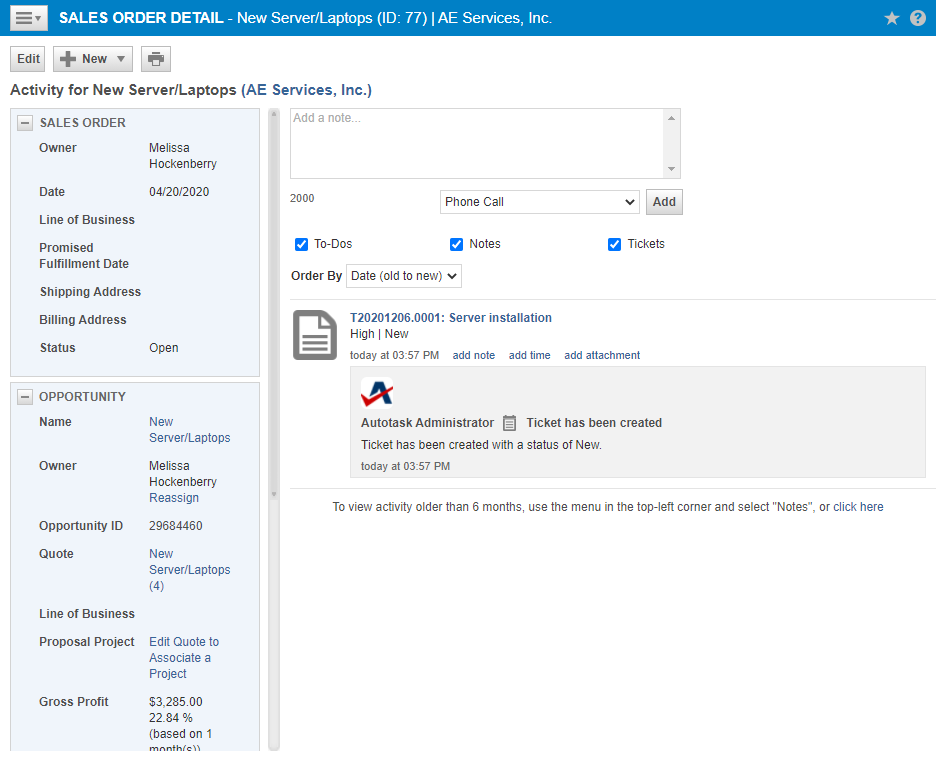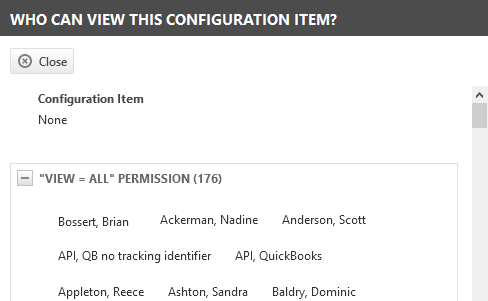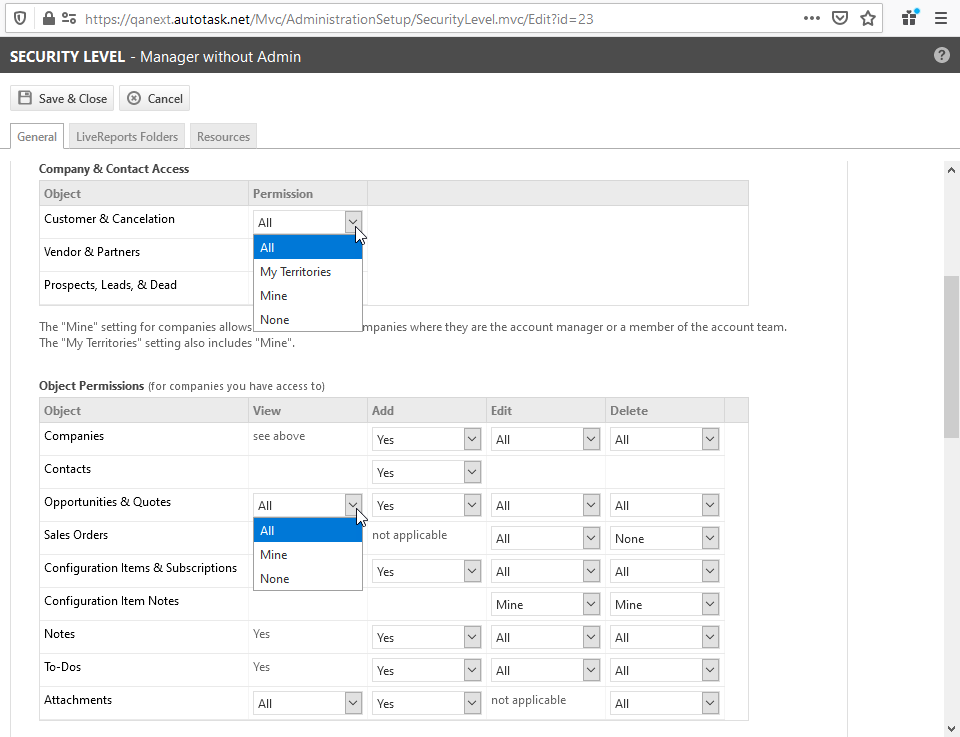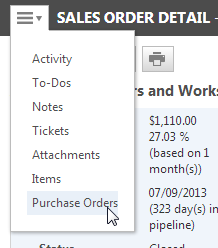The Sales Order Detail page
PERMISSIONS You must be the sales order owner or have a security level with access to CRM and sales order object permissions
Permission to view internal costs is required to view cost and profit information.
NAVIGATION Left Navigation Menu > CRM > Search > Sales Orders > click on a Sales Order
NAVIGATION Opportunity page > Sales Order link
NAVIGATION In various lists of charges associated with the sales order, for example, the Delivery/Shipping page, click the sales order name link
Sales orders are closely linked to opportunities. Just as opportunities track a deal before the sale, sales orders track quoted products after the quote is accepted and the deal is closed. They ensure that the products the customer ordered are actually delivered.
You can access, add, and manage entities associated with the sales order's opportunity, including to-dos, notes, attachments, tickets, and quotes. You will know when each quoted item is approved, purchased, received, and shipped until your sales order is fulfilled.
Sales orders are created automatically when the opportunity is closed and all of the following is true:
- The Procurement feature is enabled for your instance of Autotask
- The opportunity contains quoted products, not just labor or services
- You closed the opportunity using the Won Opportunity Wizard
A row of task buttons appears at the top of the page.
| Element | Description |
|---|---|
| Edit | Click to open the Edit Sales Order window. Refer to Editing a sales order. |
| New | Click to open the menu of new items you can add including Note, To-Do, Attachment, and Ticket (if the user has permission to create them). Click a menu item to open the form to add that item. TIP You add new items from the context menu > Items view. |
| Print icon | Click to send the visible contents of the page to a printer. |
In the default Activity view, as well as in the Notes and To-Do views, sales order information is displayed on the left side of the Sales Order Detail page.
NOTE The links described in the table will only display as a link if you have the required permission to access the element or task.
| Element | Description |
|---|---|
| Sales Order | The name of the owner, the create and promised fulfillment dates, the line of business and the shipping and billing address. You can edit the sales order to change this information. |
| Opportunity |
Click the + to show the following information for the opportunity: the opportunity name, ID and owner, quote name, proposal project, gross profit, current status, create date and rating. NOTE If you do not have permission to view internal cost data, gross profit is not visible. |
| Organization | Click the + to show the following information about the associated organization: Organization name and address, URL for the organization's Web site when available, phone and fax numbers. An icon displays when the client portal is enabled for the organization. Refer to Overview of Client Portal and Taskfire Internal Help Desk. The Site Configuration link opens a window that displays site-configuration information for the organization. Refer to The Site Configuration tab. The map link opens a map showing the customer location of the organization. |
| Contact | Click the + to display the following information for the sales order contact: name, address, phone and fax numbers, email address. |
| User-Defined Fields | Displays sales order User-Defined Fields. Fields display only when they contain information. |
| Who can View this Sales Order? |
On the Tools menu of organizations, devices, opportunities, and sales orders, a Who can view this [entity name] link appears. Click this link to learn which users have permission to view this item. View permissions for organizations are determined by the Organization & Contact Access settings of the user's security level, and for opportunities, sales orders, and devices, by the Object Permissions. Refer to CRM security settings. Additional permission to view internal costs is required to view costs and profit information. |
The Sales Order Detail page contains multiple views that display entities related to the sales order. These views are accessed from the context menu. You hover over the context menu and select an option from the drop-down list.
By default, the Activity tab is selected.
For more information on the various entity tables, refer to the following:
| Name | Description |
|---|---|
| To-Dos and Notes | Searching and managing CRM notes and to-dos |
| Tickets | The Tickets tab opens a list of tickets associated with the opportunity. Refer to Searching and managing tickets. The Tickets tab also includes two additional Opportunity-specific options not found in other search results tables: • From the right-click menu, select Disassociate to remove the ticket to opportunity association. • Click the Associate Existing Tickets button to search for tickets associated with the Opportunity Organization that are not associated with another Opportunity. You can then select tickets to associate with the opportunity. |
| Attachments | Adding and managing attachments. |
| Items | The Items view opens the list of items on the quote associated with the Sales Order. On this tab you can do the following: • Click New Item to open the New Quote Item window. When you add an item from the Sales Order Items tab, it is associated with the quote and opportunity and will be added to the Procurement process. For details on adding a new item, refer to Adding or editing a quote item. • Use the up or down arrows to change the order of the items. Note that if the "Group by Product Category" check box is selected, you cannot move items between categories. • For product item types, click the Item Name to open the associated ticket, contract, or product charge. • For all item types, click the Edit icon to modify the quote item, including Unit Price, Discount, Unit Cost and Quantity. Any changes made here are reflected on all Opportunity, Quote and Procurement pages. IMPORTANT Changes made here, however, do not update the billing items that were created as charges on a Post Sale ticket. Ticket charges can be edited directly, as long as they have not been posted, or you can create a new opportunity and quote to reflect the correct billing data. |
| Purchase Orders | Opens a table of purchase orders associated with this sales order. Refer to Searching and managing purchase orders. |
NOTE Users may not have permission to view internal ticket time entries, notes and attachments entered by other users. They will see placeholder text instead of user-entered content. Refer to Service Desk security settings.
Opportunity and Sales Order Detail pages open to the Activity view. On the Activity view, you have access to the most recent to-dos, notes, and tickets associated with the opportunity or sales order. To view an activity type, check the box for that activity. You can select one or more check boxes in any combination. When there is a new activity on an item, the item and related updates move to the top of the feed.
You can order them from new to old or old to new.
TIP To access older to-dos, notes, or ticket activities that do not appear in the Activities feed, select To-Dos, Notes, or Tickets from the context menu on the opportunity detail page.
NOTE Opportunity LiveReports can report on the date of the Last Activity. The Last Activity date is updated when the opportunity is created, edited, won or lost, and a regular note wall note or to-do is created or edited. It is also updated when an associated quote is updated.
You can choose to follow any combination of to-dos, notes, and tickets. Select the check box to display the current additions, updates, and comments associated with the selected entity.
All the additions and updates are grouped with the original item to make it easy to find them. When there is a new activity on an item, the item and all related updates move to the top of the feed.
NOTE If you select Tickets, the feed displays only the four most recent ticket activities related to this opportunity. For more ticket information, select Tickets from the opportunity detail context menu to access a list of all associated tickets. Click to open an individual ticket for a list of all activities for that ticket. .
NOTE When To-Dos is selected, the display includes only the three most recent, non-complete to-dos.
Just click a link to add your own comments or attachments and, for tickets and tasks, to add time entries. As security permissions allow, you can also edit and delete items. Your Autotask security level permissions as well as any special permissions you may have apply to all information and actions on the news feed.
You can also post notes directly to the feed.
- Enter your note in the text field above the feed.
NOTE There is a character limit of 2000. The number of available characters appears below the note text box. If you paste a note with more than 2000 characters into the box, the text will be truncated.
- Select an Action Type.
The Action Type defaults to Wall Note, but you can select a different Action Type.
- Click Add.
Your note will appear wherever notes for this organization are displayed. In order to see it in the feed, you will need to select the Notes check box.
TIP Notes you enter through the feed also appear on the Notes Tab where you can schedule a note as a to-do.
The wall feed displays activities for the previous 6 months. To view older activities, use the menu in the top left corner and select Notes, or click the link in the message at the end of the feed.







